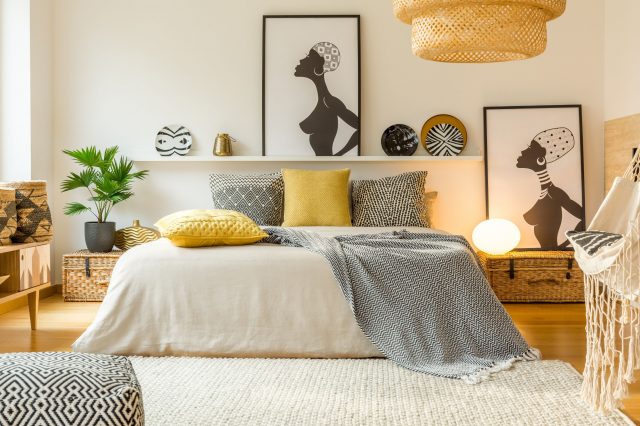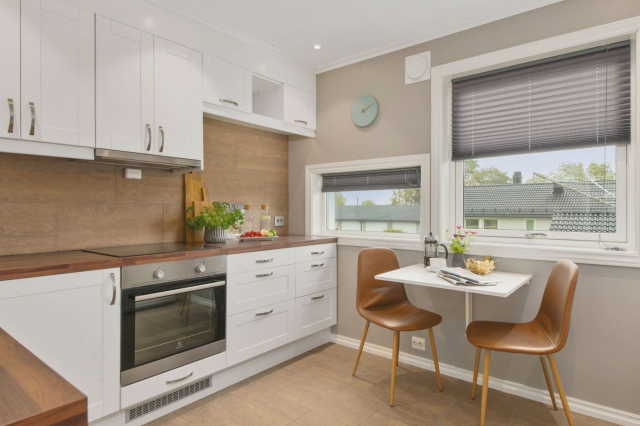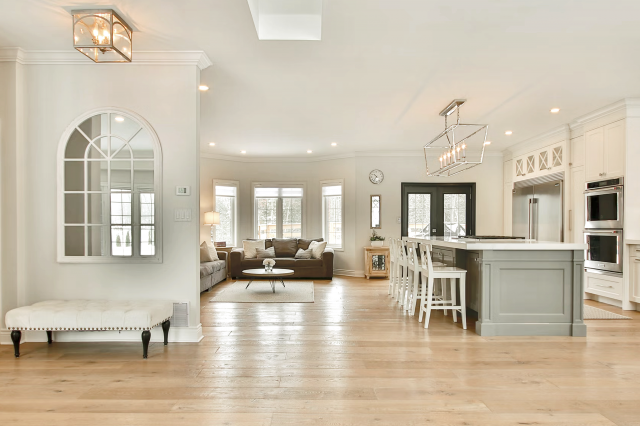How to Divide a Wall With Two Paint Colors?
Learn how to paint your wall with two different paint colors and do it correctly
Two paint colors on one wall?! Well, this is quite a popular way of paint application that is used in many homes these days. This approach allows you to make the space look and feel more vivid and dynamic, especially if you use bright and bold colors.
But if you decide to try this way of paint application, you may face one common issue: how to paint your walls with two different paint colors to get the result you want?
Well, this is what we are here today. In this article, you can find information on how to paint two colors on a wall with detailed step-by-step instructions.
But also, we will tell you about the major rules that should be followed if you want your double-colored walls to look fabulous, not ridiculous.
Painting Two Colors On One Wall. How to Do It Correctly?
Using two different colors of paint on a single wall is quite a common way of paint application in fact, even though it may not be used literally in every home! See, when you apply paint like this, it can be a good way to create the visual illusion of more space.
In addition, two paints on the same wall can help you to make the room look brighter and lighter easily. This way of paint application can also be handy if you need to create different areas in the room, especially in open-plan spaces.
However, most people find painting walls with 2 different colors quite complicated! The most bothersome thing is how to split the paint on the wall so that you get those crispy and straight lines.
In general, in order to divide a wall with two different paint colors, you need to choose a point where you want these colors to separate first of all. Once this is done, proceed with applying the top paint color first. Then mark where the split will go with the pencil, apply masking tape along the marked line, and finish by rolling on the second layer of another paint color.
The final step will be to peel off the masking tape accurately after the paint is dry.
But let us explain how to paint a wall using two paint colors with more details. Like that, you will have step-by-step instructions that you can use whenever you need them.

IgorVetushko vis VistaCreate
Table of Contents
Start With Applying the First layer Of Paint
The very first step you need to take when painting your interior walls with two different paint colors is to apply the first coat of paint. Start painting the top part of the wall first.
Why should you start with the top part instead of the bottom one, you may be wondering? See, if you start with the bottom part of the wall first, chances are that, after you proceed to paint the top area, dripping paint will ruin the hard paintwork you have just finished down there!
So start with the top and go slightly over the point where you want to start your bottom color. Once the first coat has dried, apply a second coat of paint if required.

MarkofShell via VistaCreate
Mark the Dividing Line
You will also need to draw a temporary line on the wall using a pencil or chalk when painting it with two different paint colors. This is needed so that you could divide the wall surface into two parts.
This line you draw will work as a sort of guide for applying the masking tape and doing it in a perfectly straight manner.
There are many different methods and ways you can use in order to mark a dividing line on the wall that can be used for painting two colors on one surface. The two that we will be talking about in this article can be found below.

Use a Level
This is the most precise method that you can opt for. If you are not aware of what a level is, it is a device that is used to determine whether a surface is horizontal or not.
Use a level to go from one side of the wall to the other side of it while marking the line using a pencil. You just need to be sure that the bubble of your measuring tool is exactly centered on that level to get a perfectly straight line!
Make Use Of a String
A string is another alternative way of measuring the dividing line on your wall. It may seem to be somewhat old-fashioned, but if you don’t have a level at hand, or you don’t know how to use it, opting for a string could be the best way out.
In order to mark a dividing line using a string, first of all, take a piece of string that is equal to the length of your wall. Rub this piece of string with some chalk and stick both edges of the string to the corners of the wall.
Make sure that the edges of your measuring string are at the same height so that the string is running across the wall horizontally. Now ping the string to leave a chalk line on the wall.
Apply the Masking Tape
After you have made your dividing line and it is ready, it is time to move ahead with the application of masking tape. By the way, speaking of the masking tape, we would recommend you make use of the Frog Tape’s “Delicate Surface”.
See, this is the best option since it works really well on freshly painted surfaces! Start applying the tape on the wall, going from one side towards the other, following the dividing line you’ve just drawn.

minerva86 via VistaCreate
Seal the Bottom Of the Masking Tape
This is the next step in your wall painting “odyssey”. In order to seal the bottom portion of the masking tape that you have applied to the wall, simply take the paint color that you have used for the top part of the wall and apply it over the tape using a brush.
Let this paint dry before moving on. It shouldn’t take more than thirty minutes for it to dry completely.

Apply the Second Coat Of Paint
After the masking tape is applied and sealed as it should be, you can now go ahead with painting the bottom part of the wall with the second color. While painting the bottom part, you need to keep in mind that you have to go over the taped line so that you don’t miss any spots.
But you also need to be careful enough that you don’t go past the top of the tape line into the top color!
Peel the Masking Tape Off
Finally, as soon as your coat of the second paint color is applied to the wall, you can peel the masking tape off. To do that, you don’t even need to wait for the paint to dry! Feel free to simply take off the masking tape while the paint is still wet, as this helps prevent the tape from taking off any other paint on the wall.
At this point, you should be able to see that super crisp line that separates your wall with two colors.
But, in case you see any imperfections, you can fix them using an art brush, although if you follow the above instructions, this is highly unlikely to happen.This is how you can apply two different paint colors onto the wall if you want to visually divide it horizontally.
However, not all rooms are the same, and it may happen that you need to divide your space vertically.
Luckily, this is quite easy to do. To divide a wall with two different paint colors vertically, you need to choose a point on the wall where you want the two colors to meet.
Then, apply the first color which goes past that point, mark a vertical dividing line with a pencil or chalk, and apply masking tape following that line. Then apply the second color to the remaining part of the wall and finish by taking off the tape.

IgorVetushko via VistaCreate
Things to Consider Before You Start Applying Paint Onto the Wall
Any home renovation project requires certain preparations, otherwise, if you start working unprepared, you might end up with not quite what you expected. When it comes to the application of paint, especially if we are talking about applying two distinct paint colors on the same wall, you need to be prepared exceptionally well!
The key to a beautifully painted room is to make sure that your preparation is done properly from the beginning. So before you start applying paint onto your walls, you need to make sure that you fill in any holes or indentations with crack filler and then sand that down. Remember it as a rule of thumb: your wall must be even and smooth!
Also, it is good if you have already decided on the paint colors that you will be using. But in case you haven’t decided yet, we would like to give you a general idea: stick to the lighter color on the top part of the wall and opt for the darker color on the lower part of the surface.
You will also need to decide the height where you want the colors to meet on the wall. If you are not quite sure what height to choose, then we would recommend going with the eye-level height.

VitalikRadko via VistaCreate
Rules For Two-Toned Walls
All right, now you are aware of how to paint a two-tone wall. However, it is also necessary to know certain nuances that come with this process. For example, you should be informed about when it is better to use a horizontal wall dividing with two colors, and when it is best to stick to the vertical divide.
When to Apply Two Paint Colors to Divide a Wall Horizontally
You should use the horizontal two-tone painting walls for grounding a room and creating a sense of comfort and depth. At the same time, this approach will also ensure the room feels light and bright making it airier.
This effect is typically achieved by selecting a deeper or darker shade for one of your paint colors and a lighter or paler shade for the other. In doing this, you are able to benefit from the best of both worlds instead of settling for just one paint color.

VitalikRadko via VistaCreate
When to Use a Vertical Divide?
Painting walls with two colors vertically is a good technique to use when you want to divide a room into different areas visually. For example, if you have a long and narrow elongated room that is used as a living room at one end and a dining room at the other end, two distinct paint colors can be used in order to define the different areas, in spite of it being just one room.
When to Use a Diagonal Divide?
This method is less common, however, it is still used by some people. A diagonal divide can be achieved on a wall by applying a length of masking tape at a diagonal angle across a wall and painting one color on one side of the tape and another color on the other side of the tape.
This technique is mostly used when we need to achieve an area divide in an open plan living space, but it can also be used as an interesting visual effect to give the room a modern and vibrant personality.

IgorVetushko via VistaCreate
When Is It Best to Use a Gradual Blend?
This approach is more difficult to do, but the effect can be stunning! So if you want to create a smooth and soft gradient of colors on your walls or an accent wall, for example, you should consider using this option. Besides, a gradual blend can also be done both vertically and horizontally, and even diagonally!
So, now you know how to divide a wall in your home with the help of two different paint colors, and not only how to do it, but also what methods of paint application can be used. We told you that this can be done vertically, horizontally, and even diagonally! And since you now possess detailed step-by-step instructions, you can experiment with paint colors to make your living space modern, vivid and cozy.
Ever wished paint sampling was as easy as sticking a sticker? Guess what? Now it is! Discover Samplize's unique Peel & Stick samples. Get started now and say goodbye to the old messy way!
Get paint samples




Frequently Asked Questions
⭐How to separate 2 colors on the wall?
You will need two paint colors to divide the interior of a wall in two steps: apply the top color first, mark where the split will be located in pencil, apply masking tape along the entire line, and roll on the second color, peel off the tape over.
⭐Does the darker color go above or below the chair rail?
If the furniture has the effect of being dark, a lighter wall color should be used below the chair rail. An extra layer of color can be drawn under the chair rail with lighter furniture values.
12 thoughts on “How to Divide a Wall With Two Paint Colors?”
Leave a Reply








Does anyone know how to paint a room 3 different colors? Now I have it painted one color but I’m really tired of this monochrone style! On the other hand, I have no experience in using more than one color on the walls. What could you suggest in this case?
You need to select all three colors from the warm or cool palette of the color wheel. Then, apply the lightest of the three paint colors to the ceiling. Paint an accent wall in the darkest of the three colors, and cover the remaining walls in the medium-toned paint.
How do you paint two different colors of adjoining rooms so that they look seamless? Are there any painting yricks maybe? I don’t want my home to look like a patchwork!
Well, if your adjoining rooms are painted in contrasting colors, I’d recommend you connect them by using flooring or area rugs that include both colors. For example, you can lay down a multi-color patterned runner to bring the gap between a neutral space and a more colorful one.
I faced a problem that I hope somebody will help me to solve here! I want to paint my bedroom with two colors but I can’t decide which one should be darker and what wall to apply it. When painting a room two colors, which wall should be darker?
I’d recommend you paint walls opposite windows a cool, dark color to absorb light in too-bright rooms. If you want a brighter room, you should paint a dark color on the window wall and use lighter colors opposite. It will help you reflect light back into the room.
I need your advice people. I need to paint my two-tone wall but I don’t know where to divide it! Could you please give me a few ideas on where I can divide a two tone wall to make it look harmonious?
I’d say that splitting the wall into thirds will give the best effect. If you paint the section that goes down to the floor in the deepest shade, it will help to make a room feel grounded. You should also try painting the ceiling in the lighter shade too for a seamless effect.
Is it ok to use warm yellow and leafy green on the same wall? The colors seem to combine well, but I’m still not sure.
If the color palette of the room allows this combination, why not? The colors pair well with each other.
Hi! I want to paint my walls with two colors but I’ve never done this before. Could you tell me which side of the wall must be painted darker?
Hello. I’d say, to minimize the amount of bright sunlight in a room, paint your walls opposite windows a cool, dark color. You can transform the look of a room by painting an interior window wall dark, with lighter shades opposite to reflect light back into the room in a bright light.